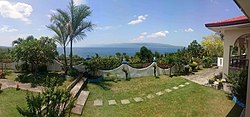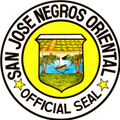San Jose, Negros Oriental
 From Wikipedia - Reading time: 11 min
From Wikipedia - Reading time: 11 min
This article needs additional citations for verification. (March 2013) |
San Jose | |
|---|---|
| Municipality of San Jose | |
 Overlooking view of Tañon Strait from San Jose | |
| Nickname: The Regional Pineapple Capital | |
 Map of Negros Oriental with San Jose highlighted | |
Location within the Philippines | |
| Coordinates: 9°25′N 123°14′E / 9.42°N 123.23°E | |
| Country | Philippines |
| Region | Negros Island Region |
| Province | Negros Oriental |
| District | 2nd district |
| Founded | 1954 |
| Barangays | 14 (see Barangays) |
| Government | |
| • Type | Sangguniang Bayan |
| • Mayor | Mel Nick S. Logronio (NP) |
| • Vice Mayor | Quirino R. Renacia (NP) |
| • Representative | Ma. Isabel L. Sagarbarria (Lakas) |
| • Municipal Council | Members |
| • Electorate | 16,693 voters (2025) |
| Area | |
• Total | 54.46 km2 (21.03 sq mi) |
| Elevation | 99 m (325 ft) |
| Highest elevation | 728 m (2,388 ft) |
| Lowest elevation | 0 m (0 ft) |
| Population (2024 census)[3] | |
• Total | 22,870 |
| • Density | 420/km2 (1,100/sq mi) |
| • Households | 5,389 |
| Economy | |
| • Income class | 5th municipal income class |
| • Poverty incidence | 20.37 |
| • Revenue | ₱ 139.6 million (2022) |
| • Assets | ₱ 301.9 million (2022) |
| • Expenditure | ₱ 142.5 million (2022) |
| • Liabilities | ₱ 90.72 million (2022) |
| Service provider | |
| • Electricity | Negros Oriental 2 Electric Cooperative (NORECO 2) |
| Time zone | UTC+8 (PST) |
| ZIP code | 6202 |
| PSGC | |
| IDD : area code | +63 (0)35 |
| Native languages | Cebuano Tagalog |
San Jose (Cebuano: Lungsod sa San Jose; Tagalog: Bayan ng San Jose), officially the Municipality of San Jose, is a municipality in the province of Negros Oriental, Philippines. According to the 2020 census, it has a population of 21,956 people.[5] It is the least populous town in Negros Oriental.
San Jose is 14 kilometres (8.7 mi) from Dumaguete.
History
[edit]The municipality of San Jose was formerly called "Ayuquitan", a name that was born due to a communication problem between the natives and Spanish Conquistadors. The story was that one day a group of Spaniards searching for flourishing communities came upon a group of natives harvesting rice. The Spaniards approached the natives and asked the name of the place while pointing to the ground filled with piles of rice chaffs. The natives thought they were asked for the name of the pile and answered "Inoquitan". From then on, the Spaniards called the place "Inoquitan". In time, the name "Ayuquitan" was adapted from the phrase "may inoquitan". In 1902 Governor Demetrio Larena considered the place as a pueblo. Pioneer Spanish Merchant is Manuel Pastor. San Jose is the home of the old Spanish families settled since 1871 like the Patero, Amiscaray, Larena, Pareja, Siglos, Remollo, Renacia, Remata, Araco, Tatel and Remoto.
San Jose was created as a town in 1954 from the barrios of Ayuquitan, Basak, Basiao, Cambaloctot, Calo, Cancawas, Hanay-Hanay, Jilocon, Lalaan, Naiba, Tapon Norte, Tampi, and sitios Guinsayawan, Kang-atid, Kangdajonog, Guilongsoran and Kaputihanan of the barrio of Siapo, all of which formerly belonged to the former municipality of Ayuquitan and then part of the municipality of Amlan.[6]
Geography
[edit]Barangays
[edit]San Jose is politically subdivided into 14 barangays. Each barangay consists of puroks and some have sitios.
| PSGC | Barangay | Population | ±% p.a. | |||
|---|---|---|---|---|---|---|
| 2024[7] | 2010[8] | |||||
| 074617001 | Basak | 3.8% | 870 | 888 | −0.14% | |
| 074617002 | Basiao | 3.0% | 693 | 596 | 1.06% | |
| 074617004 | Cambaloctot | 3.0% | 693 | 557 | 1.54% | |
| 074617005 | Cancawas | 7.7% | 1,758 | 1,527 | 0.99% | |
| 074617006 | Janayjanay | 4.8% | 1,089 | 933 | 1.09% | |
| 074617007 | Jilocon | 8.8% | 2,004 | 1,728 | 1.04% | |
| 074617008 | Naiba | 4.5% | 1,040 | 671 | 3.12% | |
| 074617009 | Poblacion | 4.0% | 915 | 1,035 | −0.86% | |
| 074617010 | San Roque | 3.7% | 853 | 816 | 0.31% | |
| 074617011 | Santo Niño | 11.0% | 2,509 | 2,195 | 0.94% | |
| 074617012 | Señora Ascion (Calo) | 8.7% | 1,980 | 1,690 | 1.12% | |
| 074617013 | Siapo | 10.3% | 2,357 | 2,136 | 0.69% | |
| 074617014 | Tampi | 9.9% | 2,260 | 1,837 | 1.46% | |
| 074617015 | Tapon Norte | 12.8% | 2,935 | 2,489 | 1.16% | |
| Total | 22,870 | 19,098 | 1.27% | |||
Climate
[edit]| Climate data for San Jose, Negros Oriental | |||||||||||||
|---|---|---|---|---|---|---|---|---|---|---|---|---|---|
| Month | Jan | Feb | Mar | Apr | May | Jun | Jul | Aug | Sep | Oct | Nov | Dec | Year |
| Mean daily maximum °C (°F) | 28 (82) |
30 (86) |
31 (88) |
32 (90) |
32 (90) |
30 (86) |
30 (86) |
30 (86) |
30 (86) |
29 (84) |
30 (86) |
30 (86) |
30 (86) |
| Mean daily minimum °C (°F) | 21 (70) |
22 (72) |
22 (72) |
23 (73) |
24 (75) |
25 (77) |
24 (75) |
24 (75) |
24 (75) |
24 (75) |
23 (73) |
21 (70) |
23 (74) |
| Average precipitation mm (inches) | 26 (1.0) |
22 (0.9) |
28 (1.1) |
41 (1.6) |
95 (3.7) |
136 (5.4) |
147 (5.8) |
126 (5.0) |
132 (5.2) |
150 (5.9) |
98 (3.9) |
46 (1.8) |
1,047 (41.3) |
| Average rainy days | 7.5 | 6.7 | 8.9 | 10.4 | 21.6 | 25.6 | 26.3 | 25.0 | 24.1 | 26.2 | 19.2 | 12.1 | 213.6 |
| Source: Meteoblue[9] | |||||||||||||
Demographics
[edit]| Year | Pop. | ±% p.a. |
|---|---|---|
| 1960 | 7,547 | — |
| 1970 | 8,840 | +1.59% |
| 1975 | 9,517 | +1.49% |
| 1980 | 10,938 | +2.82% |
| 1990 | 12,821 | +1.60% |
| 1995 | 14,952 | +2.92% |
| 2000 | 15,665 | +1.00% |
| 2007 | 17,250 | +1.34% |
| 2010 | 19,098 | +3.77% |
| 2015 | 20,413 | +1.28% |
| 2020 | 21,956 | +1.55% |
| 2024 | 22,870 | +0.98% |
| Source: Philippine Statistics Authority[10][11][8][12][13] | ||
Economy
[edit]Poverty incidence of San Jose
10
20
30
40
2000
39.30 2003
33.71 2006
26.20 2009
28.74 2012
28.76 2015
32.47 2018
17.10 2021
20.37 Source: Philippine Statistics Authority[14][15][16][17][18][19][20][21] |
Education
[edit]The public schools in the town of San Jose are administered by one school district under the Schools Division of Negros Oriental.
Elementary schools:
- Alicia C. Calumpang Elementary School — Naiba
- Basak Elementary School — Basak
- Cancawas Elementary School — Cancawas
- Crisostomo O. Retes Elementary School (formerly Tampi ES) — Tampi
- Guilongsoran Primary School — Sitio Guilongsoran, Siapo
- Janayjanay Elementary School — Janayjanay
- Jose R. Remollo Elementary School — Cambaloctot
- Pedro A. Remoto Elementary School — Jilocon
- San Jose Central Elementary School — Nat'l Highway, Poblacion
- San Roque Elementary School — San Roque
- Siapo Elementary School — Siapo
- Sra. Ascion Elementary School (formerly Calo ES) — Sra. Ascion
- Tapon Norte Elementary School — Tapon Norte
High schools:
- Cambaloctot High School — Cambaloctot
- Crisostomo O. Retes National High School (formerly Tampi NHS) — Tampi
- San Jose Provincial High School — Poblacion
- Siapo High School — Siapo
Tourism
[edit]The town is the gateway to the Balinsasayao Twin Lakes Natural Park in Enrique Villanueva, Sibulan Town.
One of the tourist attraction of the town was the Our Lady of Lourdes Shrine in the cane fields of Sto. Niño, where a spinning sun is said to have manifested the visit of the Lady of Lourdes, devotees flock every Saturday of the month.
The Ayuquitan Festival is held every May 7, one of the highlights of the town fiesta which is celebrated on May 10. Street dancing and showdown are the main features of the festival.
The St. Paul University Farm is located in Barangay Sra. Acion.
The Port of Tampi also serves RORO services going to the island of Cebu through the Port of Bato in the municipality of Samboan.
References
[edit]- ^ Municipality of San Jose | (DILG)
- ^ "2015 Census of Population, Report No. 3 – Population, Land Area, and Population Density" (PDF). Philippine Statistics Authority. Quezon City, Philippines. August 2016. ISSN 0117-1453. Archived (PDF) from the original on May 25, 2021. Retrieved July 16, 2021.
- ^ "2024 Census of Population (POPCEN) Population Counts Declared Official by the President". Philippine Statistics Authority. 17 July 2025. Retrieved 18 July 2025.
- ^ "PSA Releases the 2021 City and Municipal Level Poverty Estimates". Philippine Statistics Authority. 2 April 2024. Retrieved 28 April 2024.
- ^ "2024 Census of Population (POPCEN) Population Counts Declared Official by the President". Philippine Statistics Authority. 17 July 2025. Retrieved 18 July 2025.
- ^ "Act 1212". Retrieved 2 December 2022.
- ^ Census of Population (2020). "Region VII (Central Visayas)". Total Population by Province, City, Municipality and Barangay. Philippine Statistics Authority. Retrieved 8 July 2021.
- ^ a b Census of Population and Housing (2010). "Region VII (Central Visayas)" (PDF). Total Population by Province, City, Municipality and Barangay. National Statistics Office. Retrieved 29 June 2016.
- ^ "San Jose: Average Temperatures and Rainfall". Meteoblue. Retrieved 6 May 2020.
- ^ "2024 Census of Population (POPCEN) Population Counts Declared Official by the President". Philippine Statistics Authority. 17 July 2025. Retrieved 18 July 2025.
- ^ Census of Population (2015). "Region VII (Central Visayas)". Total Population by Province, City, Municipality and Barangay. Philippine Statistics Authority. Retrieved 20 June 2016.
- ^ Censuses of Population (1903–2007). "Region VII (Central Visayas)". Table 1. Population Enumerated in Various Censuses by Province/Highly Urbanized City: 1903 to 2007. National Statistics Office.
- ^ "Province of". Municipality Population Data. Local Water Utilities Administration Research Division. Retrieved 17 December 2016.
- ^ "Poverty incidence (PI):". Philippine Statistics Authority. Retrieved December 28, 2020.
- ^ "Estimation of Local Poverty in the Philippines" (PDF). Philippine Statistics Authority. 29 November 2005.
- ^ "2003 City and Municipal Level Poverty Estimates" (PDF). Philippine Statistics Authority. 23 March 2009.
- ^ "City and Municipal Level Poverty Estimates; 2006 and 2009" (PDF). Philippine Statistics Authority. 3 August 2012.
- ^ "2012 Municipal and City Level Poverty Estimates" (PDF). Philippine Statistics Authority. 31 May 2016.
- ^ "Municipal and City Level Small Area Poverty Estimates; 2009, 2012 and 2015". Philippine Statistics Authority. 10 July 2019.
- ^ "PSA Releases the 2018 Municipal and City Level Poverty Estimates". Philippine Statistics Authority. 15 December 2021. Retrieved 22 January 2022.
- ^ "PSA Releases the 2021 City and Municipal Level Poverty Estimates". Philippine Statistics Authority. 2 April 2024. Retrieved 28 April 2024.
 KSF
KSF



